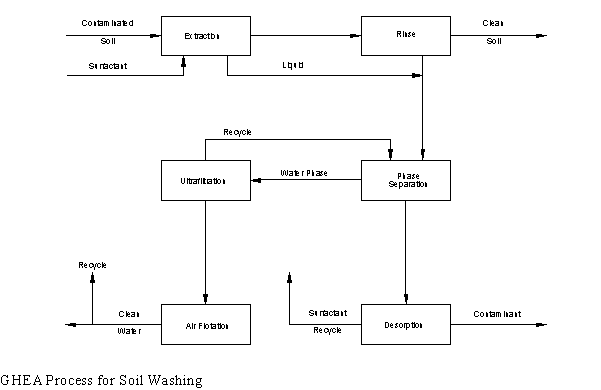
The GHEA Associates process applies surfactants and additives to soil washing and wastewater treatment to make organic and metal contaminants soluble. In soil washing, soil is first excavated, washed, and rinsed to produce clean soil. Wash and rinse liquids are then combined and treated to separate surfactants and contaminants from the water. Next, contaminants are separated from the surfactants by desorption and isolated as a concentrate. Desorption regenerates the surfactants for repeated use in the process.
The liquid treatment consists of a sequence of steps involving phase separation, ultrafiltration, and air flotation (see figure below). The treated water meets all National Pollutant Discharge Elimination System groundwater discharge criteria, allowing it to be (1) discharged without further treatment, and (2) reused in the process itself or reused as a source of high quality water for other users.
In wastewater treatment applications, surfactants added to the wastewater adsorb contaminants. The mixture is then treated in the same manner as described above for (1) water purification, (2) separation of the contaminants, and (3) recovery of the surfactants. The treatment process yields clean soil, clean water, and a highly concentrated fraction of contaminants. No other residues, effluents, or emissions are produced. The figure below illustrates the GHEA process.

This technology can be applied to soil, sludges, sediments, slurries, groundwater, surface water, end-of-pipe industrial effluents, and in situ soil flushing. Contaminants that can be treated include both organics and heavy metals, nonvolatile and volatile organic compounds, and highly toxic refractory compounds.
The technology was accepted into the SITE Emerging Technology Program in June 1990. Treatability tests were conducted on various matrices, including soils with high clay contents, industrial oily sludges, industrial wastewater effluents, and contaminated groundwater (see table below). In situ soil flushing tests have shown a 20-fold enhancement of contaminant removal rates. Tests using a 25-gallon pilot-scale plant have also been conducted. The Emerging Technology Bulletin (EPA/540/F-94/509), which details evaluation results, is available from EPA. Costs for treatment range from $50 to $80 per ton.
| SUMMARY OF TREATABILITY TEST RESULTS | |||
|---|---|---|---|
| MATRIX | UNTREATED SAMPLE | TREATED SAMPLE | PERCENT REMOVAL |
| Volatile Organic Compounds (VOC): Trichloroethene; 1,2-Dichloroethene; Benzene; Toluene | |||
| Soil, parts per million (ppm) | 20.13 |
0.05 |
99.7% |
| Water, parts per billion (ppb) | 109.0 |
2.5 |
97.8% |
| Total Petroleum Hydrocarbons (TPH): | |||
| Soil, ppm | 13,600 |
80 |
99.4% |
| Polychlorinated Biphenyls (PCB): | |||
| Soil, ppm | 380.00 |
0.57 |
99.8% |
| Water, ppb | 6,000.0 |
<0.1 |
>99.9% |
| Trinitrotoluene in Water, ppm | 180.0 |
<.08 |
>99.5% |
| Coal Tar Contaminated Soil (ppm): | |||
| Benzo[a]pyrene | 28.8 |
<0.1 |
>99.7% |
| Benzo[a]fluoranthene | 24.1 |
4.4 |
81.2% |
| Chrysene | 48.6 |
<0.1 |
>99.8% |
| Benzanthracene | 37.6 |
<0.1 |
>99.7% |
| Pyrene | 124.2 |
<0.1 |
>99.9% |
| Anthracene | 83.6 |
<0.1 |
>99.8% |
| Phenanthrene | 207.8 |
<0.1 |
>99.9% |
| Fluorene | 92.7 |
<0.1 |
>99.9% |
| Dibenzofuran | 58.3 |
<0.1 |
>99.8% |
| 1-Methylnaphthalene | 88.3 |
1.3 |
98.5% |
| 2-Methylnaphthalene | 147.3 |
<0.1 |
>99.9% |
| Heavy Metals in Soil: | |||
| Chromium, ppm | 21,000 |
640 |
96.8% |
| Iron (III) in Water, ppm: | 30.8 |
0.3 |
99.0% |
EPA PROJECT MANAGER:
Brunilda Dávila
U.S. EPA
National Risk Management Research Laboratory
26 West Martin Luther King Drive
Cincinnati, OH 45268
513-569-7849
Fax: 513-569-7620
TECHNOLOGY DEVELOPER CONTACT:
Itzhak Gotlieb
GHEA Associates
5 Balsam Court
Newark, NJ 07068
201-226-4642
Fax: 201-703-6805